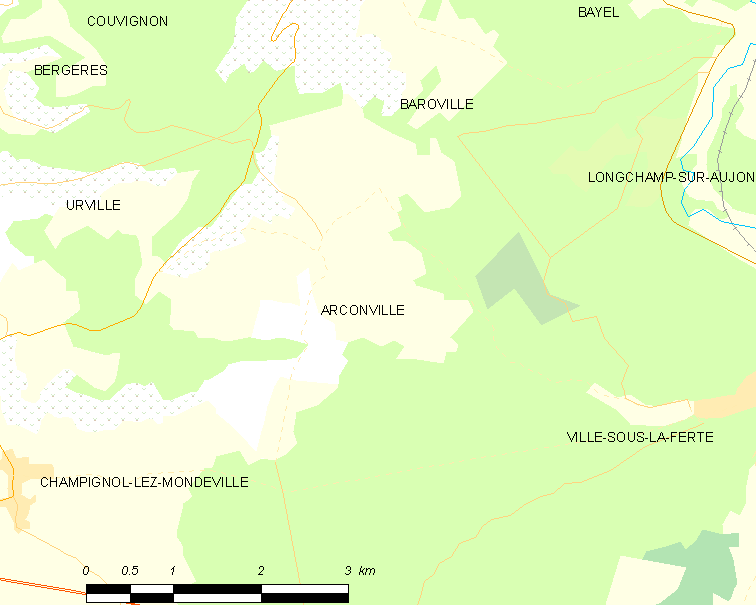 Key facts
Key facts
Located in subregion/area: Côte des Bar / Bar-sur-Aubois
Vineyards and grape varieties: 59.1 hectares (146.0 acres), of which 88% Pinot Pinot, 10.5% Chardonnay, 1.2% Pinot Meunier, and 0.5% others.
Classification: ”Autre cru” (80%)
Maps

The map is linked from Wikimedia Commons, and the geographical information originates from OpenStreetMap. The dotted white area corresponds to the vineyards, light yellow is other open terrain, orange is built-up areas, and green indicates forest.
Google Maps view with the villages in the Bar-sur-Aubois highlighted.
Clicking on a village opens a field to the left with a link to the village profile, if it exists.
Neighbouring villages within the Champagne appellation
North: Baroville
Southwest: Champignol-lez-Mondeville
Westnorthwest: Urville
The village
Arconville is located at some some small streams that combine and then empty in the Aube river in Ville-sous-la-Ferté, the neighbouring commune.
The Arconville commune covers 1500 hectares and has 111 inhabitants (as of 2014), referred to as Arconvillois and Arconvilloises.
Vineyards
The vineyards in Arconville are located in a block to the northwest of the village and include a large proportion of southeast-facing slopes. Pinot Noir is the most common grape variety, by a wide margin.
The current vineyard surface in the Arconville commune is 59.1 hectares (146.0 acres). There are 51.9 ha Pinot Pinot (87.8%), 6.2 ha Chardonnay (10.5%), 0.7 ha Pinot Meunier (1.2%), and 0.3 ha others (0.5%). Numbers from CIVC, as of 2013. In 1997, the vineyard surface was 53 ha. There are 20 vineyard owners (exploitants) in the commune.
Champagne producers
Champagne growers
Producer status is indicated where known: RM = récoltant-manipulant, or grower-producers. RC = récoltant-coopérateur, growers that are cooperative members but sell Champagnes under their own name.
- Bernard Gaucher (RM, Facebook page), has 10.5 ha of vineyards (information from 2009) in two villages. Decided in 1985 to produce Champagnes of their own.
Comment: the list may be incomplete.
Links
- Wikipedia about this village in English, in French.
- Website of the Arconville commune.
- UMC’s village profile of Arconville.
- Vineyard map of Arconville at weinlagen-info.de.
- Picture of vineyards in Arconville.
- The Swedish version of this post.
© Tomas Eriksson 2017, last update 2017-01-21
